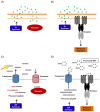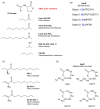Specificity and complexity in bacterial quorum-sensing systems
- PMID: 27354348
- PMCID: PMC5007282
- DOI: 10.1093/femsre/fuw014
Specificity and complexity in bacterial quorum-sensing systems
Abstract
Quorum sensing (QS) is a microbial cell-to-cell communication process that relies on the production and detection of chemical signals called autoinducers (AIs) to monitor cell density and species complexity in the population. QS allows bacteria to behave as a cohesive group and coordinate collective behaviors. While most QS receptors display high specificity to their AI ligands, others are quite promiscuous in signal detection. How do specific QS receptors respond to their cognate signals with high fidelity? Why do some receptors maintain low signal recognition specificity? In addition, many QS systems are composed of multiple intersecting signaling pathways: what are the benefits of preserving such a complex signaling network when a simple linear 'one-to-one' regulatory pathway seems sufficient to monitor cell density? Here, we will discuss different molecular mechanisms employed by various QS systems that ensure productive and specific QS responses. Moreover, the network architectures of some well-characterized QS circuits will be reviewed to understand how the wiring of different regulatory components achieves different biological goals.
Keywords: chemical signaling; gene expression; group behavior; intercellular communication; regulatory network.
© FEMS 2016.
Figures



References
-
- Aravind L, Anantharaman V, Balaji S, et al. The many faces of the helix-turn-helix domain: transcription regulation and beyond. FEMS Microbiol Rev. 2005;29:231–62. - PubMed
-
- August PR, Grossman TH, Minor C, et al. Sequence analysis and functional characterization of the violacein biosynthetic pathway from Chromobacterium violaceum. J Mol Microb Biotech. 2000;2:513–9. - PubMed
-
- Bae T, Clerc-Bardin S, Dunny GM. Analysis of expression of prgX, a key negative regulator of the transfer of the Enterococcus faecalis pheromone-inducible plasmid pCF10. J Mol Biol. 2000;297:861–75. - PubMed
Publication types
MeSH terms
Substances
Grants and funding
LinkOut - more resources
Full Text Sources
Other Literature Sources
Molecular Biology Databases

